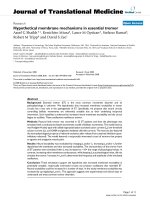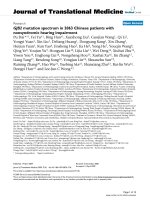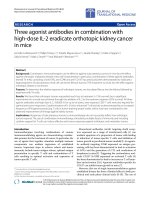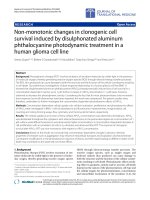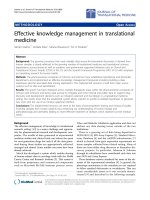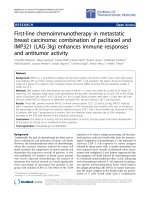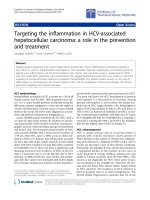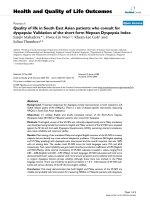Báo cáo hóa học: " Investigation into Photoconductivity in Single CNF/TiO2-Dye Core–Shell Nanowire Devices" potx
Bạn đang xem bản rút gọn của tài liệu. Xem và tải ngay bản đầy đủ của tài liệu tại đây (460.5 KB, 7 trang )
NANO EXPRESS
Investigation into Photoconductivity in Single CNF/TiO
2
-Dye
Core–Shell Nanowire Devices
Zhuangzhi Li
•
Caitlin Rochford
•
F. Javier Baca
•
Jianwei Liu
•
Jun Li
•
Judy Wu
Received: 26 April 2010 / Accepted: 3 June 2010 / Published online: 15 June 2010
Ó The Author(s) 2010. This article is published with open access at Springerlink.com
Abstract A vertically aligned carbon nanofiber array
coated with anatase TiO
2
(CNF/TiO
2
) is an attractive
possible replacement for the sintered TiO
2
nanoparticle
network in the original dye-sensitized solar cell (DSSC)
design due to the potential for improved charge transport
and reduced charge recombination. Although the reported
efficiency of 1.1% in these modified DSSC’s is encourag-
ing, the limiting factors must be identified before a higher
efficiency can be obtained. This work employs a single
nanowire approach to investigate the charge transport in
individual CNF/TiO
2
core–shell nanowires with adsorbed
N719 dye molecules in dark and under illumination. The
results shed light on the role of charge traps and dye
adsorption on the (photo) conductivity of nanocrystalline
TiO
2
CNF’s as related to dye-sensitized solar cell
performance.
Keywords Photoconductivity Á Nanowire Á Titanium
dioxide Á Dye-sensitized solar cell Á Core–shell
Introduction
Recently, many efforts in solar cell development have
employed nontraditional schemes that are different from
the conventional planar semiconductor p-n junction design
in order to focus on simplifying fabrication and decreasing
cost while maintaining a competitive efficiency. Of these
solar cell designs, the most promising is the dye-sensitized
solar cell (DSSC), first reported in 1991 to have an effi-
ciency of 7.1% [1]. Since then, the efficiency has been
pushed to over 10% [2, 3], but the theoretical limit of 31%
[4] for a single junction semiconductor photovoltaic device
remains far from reach.
Many attempts have been made to improve the original
DSSC design and circumvent its inherent limitations,
especially the low conductivity of the disordered TiO
2
nanoparticle film and potential charge recombination at the
TiO
2
surface [5, 6]. One promising approach is to replace
the nanoparticle network with a vertically aligned nanotube
[7–10] or nanowire [11–17] array, which provides the
electrons with a direct, uninterrupted route to the anode.
Even though this variation is expected to improve the
performance, the efficiency of the modified DSSC typically
remains in the\1–5% range. Many explanations have been
proposed for why the above modifications have failed to
improve the performance, including an insufficiently large
surface area for dye adsorption compared to the nanopar-
ticle film [8, 12], air trapped inside the nanotubes [9], and
large series resistance between the nanostructure and the
electrodes [7, 8]. A detailed analysis of the modified
structures within the new designs is therefore desired and
critical in order to elucidate the failure mechanisms and
quantify their effects.
In order to achieve this, we propose a sequential method,
which disassembles the modified DSSC in order to gather
Z. Li
Department of Physics, Hebei Normal University and Hebei
Advanced Thin Film Laboratory, 050016 Shijiazhuang,
People’s Republic of China
C. Rochford (&) Á J. Wu
Department of Physics and Astronomy, University of Kansas,
Lawrence, KS 66045, USA
e-mail:
F. Javier Baca
Los Alamos National Laboratory, Los Alamos, NM 87545, USA
J. Liu Á J. Li
Department of Chemistry, Kansas State University, Manhattan,
KS 66506, USA
123
Nanoscale Res Lett (2010) 5:1480–1486
DOI 10.1007/s11671-010-9665-3
information that cannot be obtained once a bulk device has
been assembled. With this strategy, one can track the
contribution of each component and identify which step or
interface is most responsible for the poor performance.
Further, each component can be optimized individually by
making systematic and controlled modifications.
Core–shell nanowires of carbon nanofiber coated with
anatase TiO
2
(CNF/TiO
2
) will be the subject of this study.
In a recent work, a vertically aligned CNF/TiO
2
nanowire
array was employed to replace the sintered TiO
2
nano-
particle network [16]. The observation of complete fluo-
rescence quenching suggests that the CNF readily accepts
photoexcited electrons from the TiO
2
[17]. This allows the
electrons to be transported through the higher-conductivity
CNF core instead of the lower-conductivity TiO
2
shell,
improving charge transport and decreasing recombination.
Additionally, this structure offers an enhanced surface area
for dye adsorption compared to traditional nanowires
(NWs) due to the rough TiO
2
surface. Despite these
expected improvements, the efficiency of the CNF/TiO
2
modified DSSC was much below that of the original DSSC.
To understand the underlying physics behind the low
efficiency, we have investigated charge transport properties
and photoconductivity of single CNF/TiO
2
-dye NW
devices.
Experiment
The CNF/TiO
2
core–shell NW samples were prepared by
depositing a particulate anatase TiO
2
film for 30 min at
500 ° C onto a vertically aligned carbon nanofiber (VAC-
NF) array by metal–organic chemical vapor deposi-
tion (MOCVD) [17]. The VACNFs used are a subset of
multi-walled CNTs grown by plasma-enhanced chemical
vapor deposition (PECVD) on silicon substrates [18–20].
The details of the growth have been described elsewhere
[16, 17]. To fabricate individual CNF/TiO
2
core–shell NW
devices as schematically shown in Fig. 1a, the as-grown
NWs were dispersed into ethanol and transferred onto a
silicon substrate covered with 500 nm thermally grown
silicon dioxide. Bi-layer electron beam resist (PMMA/
MMA-MAA) was used in the electron beam lithography
(EBL) process for the definition of two or four electrodes.
Before electrode deposition, a subset of the samples was
treated with O
2
plasma at 20 W for 30 s via reactive ion
Fig. 1 a Schematic diagram of
a single CNF/TiO
2
core–shell
NW device. b SEM image of a
device used in the study. Inset
shows a four-probe device used
to measure contact resistance
and resistivity. c TEM image
showing the core–shell structure
of the CNF/TiO
2
NW. The
yellow dashed line shows the
interface between the TiO
2
shell
and CNF core. d Microstructure
of the core–shell NW, insets
give the FFT results for the shell
and core, respectively
Nanoscale Res Lett (2010) 5:1480–1486 1481
123
etching (RIE) at a pressure of 7.1 mTorr in order to remove
any possible residual electron beam resist and other surface
contaminants that could prevent Ohmic contact between
the electrodes and TiO
2
shell. Ti (15 nm)/Au (120 nm)
electrodes were deposited by using electron beam evapo-
ration through the EBL-defined mask followed by liftoff
with acetone. After fabrication, all samples were annealed
at 400 °C for 30 min with a temperature ramping rate of
15 °C/min. The annealing was performed in vacuum at a
pressure of *10
-5
Torr or better, with the intention of
avoiding oxidation of Ti in the bottom layer of the elec-
trode and desorbing any possible residual chemicals on the
surface of the nanowire due to the above processes. To
attach dye molecules onto the TiO
2
surface of the CNF/
TiO
2
core–shell NW device, the O
2
plasma treated and
untreated samples were soaked in 0.2 mM ethanol solution
of cis-bis (isothiocyanoto) bis (2,2
0
-bipyridyl-4,4
0
-dicarb-
oxylato)-ruthenium(II) bis- tetrabutylammonium dye (N719,
Solaronix) for 12 h and blown dry with pure N
2
. The
soaking and mounting of the samples were performed in
dark in order to limit the premature exposure of the devices
to light. The prepared samples were enclosed in an alu-
minum box in order to measure the dark I–V characteristics
before exposure to one sun illumination (100 mW/cm
2
)
produced by a solar simulator outfitted with an AM 1.5 G
filter (Newport).
Results and Discussion
Figure 1a schematically depicts the structure of the CNF/
TiO
2
-dye core–shell NW device. It consists of a CNF/TiO
2
core/shell NW with two metal electrodes on the surface of
the TiO
2
sheath. A scanning electron microscopy (SEM)
image of a representative CNF/TiO
2
core/shell NW device
is shown in Fig. 1b. The NW in the device has a stem
length of *4 lm. Additionally, a four-probe device is
shown in the inset of Fig. 1b, which was fabricated to
measure the contact resistance between the metal probes
and the NW. The CNF core of the NW has an average
diameter of *100 nm, while the TiO
2
sheath of the sam-
ples used in this study is about 10–15 nm thick [17]. The
microstructures and morphologies of the CNF/TiO
2
core–
shell NW were studied using high-resolution transmission
electron microscopy (HRTEM). As shown in Fig. 1c, TiO
2
forms a conformal particulate film surrounding the CNF
core, covering the CNF core uniformly even at a kink of
the CNF, which is shown by the dashed line at the interface
of the core and shell. Fast Fourier Transform (FFT) was
used to analyze the crystalline structure of CNF core and
TiO
2
shell. Distinct ordered planes as suggested by the
discrete spots were observed on CNF (right inset of
Fig. 1d), while a mixture of compact fine grains several
nanometers in size embedded in an amorphous phase was
suggested for the TiO
2
sheath (left inset of Fig. 1d). X-ray
diffraction analysis on CNF/TiO
2
NW array indicates the
fine grains are anatase TiO
2
[17]. HRTEM suggests the
dimension of the grains is in the range of 3-5 nm.
Figure 2a shows the I–V characteristics of Sample d1,
which is a representative in a group of six samples not
treated with O
2
plasma, in dark and under illumination
before and after dye attachment. Although only the positive
bias is shown, it should be noted that the curve is sym-
metric. Contact resistance in the range of 3–8 MX was
typically observed for the untreated samples. As previously
mentioned, this large contact resistance is likely due to a
contaminated TiO
2
surface, which may prevent Ohmic
contact between Ti and TiO
2
during metal evaporation and
the diffusion of Ti to TiO
2
during annealing. Before dye
attachment, Sample d1 exhibits a considerably high dark
current (open black circles). This may be attributed to the
large number of dangling bonds and the interfaces in the
amorphous TiO
2
phase and between crystallites and
amorphous TiO
2
phase in the TiO
2
sheath. The resulting
high density of oxygen vacancies may act as electron
donors and therefore cause substantial dark current. The
illuminated current (open red circles) is only slightly higher
than the dark current before dye attachment, which may
contain direct band transition in the TiO
2
(E
g
* 3.4 eV)
close to the UV end of the solar spectrum and sub-band
(a)
(b)
Fig. 2 a Dark and illuminated
I–V curves for Sample d1
without and with dye and
b the corresponding curves
for Sample d2
1482 Nanoscale Res Lett (2010) 5:1480–1486
123
transition of TiO
2
. The sub-band transition is commonly
seen in nanostructured TiO
2
and is due to localized defect-
induced band gap states. Furthermore, the measurement on
uncoated individual CNF samples (not shown) exhibits no
photoresponse under the conditions presented in this paper,
suggesting the observed photoresponse is due to the TiO
2
or dye only.
After attaching dye molecules, the dark (solid black
squares) and illuminated (solid red squares) current of
Sample d1 decreased noticeably as shown in Fig. 2a. We
speculate that the decrease is due to the passivation of some
hole traps during the dye attachment. The current decrease
may then be explained in the following way. It has been
suggested that non-equilibrium holes rapidly become
trapped in deep traps, which may be concentrated in par-
ticular regions due to inhomogeneity in the lattice such as
grain boundaries. These traps produce a local potential
barrier that prohibits electrons from readily recombining
with the holes, thus separating charge carriers and
improving conductivity [21]. The N719 dye is expected to
attach to the TiO
2
surface via its carboxyl group [22].
While the sample is soaking in solution, the protons that
previously resided on the now negatively charged carboxyl
group may passivate some of the hole traps near the sur-
face. These hole traps are commonly associated with
oxygen vacancies, which can readily occur on the surface
as well as at the grain boundaries within the nanocrystal-
line/amorphous TiO
2
.
Even though both the dark and illuminated currents
decreased, the photo-induced current, defined as the dif-
ference between the illuminated and dark currents at a
particular bias, increased after dye attachment. This sug-
gests that the dye molecules do in fact contribute to
the photo-induced current, or more specifically, the free
electron density. This may occur in three ways. First, the
dye molecules may inject photo-excited electrons into the
TiO
2
layer and increase the electron density. It should be
recognized that dye regeneration may not occur effec-
tively in this case due to absence of the electrolyte, so this
mechanism is not expected to contribute to the measured
current. Second, the presence of the dye molecules may
modify the number of the hole traps, as argued earlier.
This mechanism will be demonstrated further via transient
photoconductivity measurements. Third, since the mea-
surements occur in air, which contains molecular oxygen,
a known electron scavenger [23], the presence of the dye
molecules may block some of the molecular oxygen from
removing conduction electrons and forming adsorbed O
2
-
sites that decreases the free electron density in the TiO
2
.
Measurements of single CNF/TiO
2
nanowires in vacuum
(not shown) exhibit a current that is 1–2 orders of mag-
nitude higher than in air. This is in qualitative agreement
with studies on thin films of nanocrystalline TiO
2
[24, 25]
in which environments containing lower oxygen content
resulted in higher current due to the decreased number of
electron scavengers. This suggests that blocking access
to the surface of the TiO
2
would have a similar effect
and thus increase the electron concentration and hence
current.
The I–V measurements were repeated on Sample d2,
which is representative of the samples with electrode
contact area treated with O
2
plasma before electrode
deposition. The O
2
plasma treatment improved the elec-
trical contact to the CNF/TiO
2
NW considerably as shown
in Fig. 2b. From four-probe measurements, the contact
resistance of the treated samples is several to several tens
of kX, which is two to three orders of magnitude smaller
than that of the untreated samples. The resistivity of
Sample d2 is estimated to be (6.4 ± 2.1) 9 10
-2
X cm.
This value seems reasonable since it lies between the
intrinsic resistivity of CNF (0.4–7 9 10
-3
X cm [26–28])
and that of TiO
2
thin films (2.6 9 10
-1
–10
6
X cm
[29, 30]). The low resistivity of the core–shell nanowire
compared to thin film TiO
2
suggests that the CNF does in
fact contribute to the charge transport even when both
electrical contacts are on the TiO
2
shell. This indicates low
resistance across the CNF/TiO
2
interface. This low-resis-
tance interface may be understood from the growth
chemistry of the TiO
2
shell on CNF. During PECVD, a
mixture of C
2
H
2
(at 62 sccm) and NH
3
(at 252 sccm) was
used as gas precursor. Particularly, the NH
3
content is
about four times that of C
2
H
2
. This generates an important
plasma etching effect to remove the amorphous carbon,
which may be deposited at the CNF surface. For many
carbon nanotube studies, the amorphous carbon has been
the major factor affecting the interface properties. The
hydrogen atoms covalently bonded to the CNF surface at
the graphitic edge do not seem to be a problem. Four-probe
electrical measurements with side contact by Zhang et al.
[28] did not show any evidence of an interface problem.
In addition, during MOCVD of TiO
2
, the oxygen atoms
involved in the reaction will likely react with hydrogen and
form a C–O bond before TiO2 is deposited. The I–V
characteristics become more linear after O
2
plasma treat-
ment, which indicates an Ohmic contact on the metal–
semiconductor interface. The reduction of the contact
resistance results in a significant current enhancement of
almost two orders of magnitude both in dark and under
illumination when compared to the untreated Sample d1.
In addition, the photo-induced current in Sample d2 is
significantly higher than in d1. At 100 mV bias, the photo-
induced current in Sample d2 is *0.21 lA after dye
attachment, which is about two orders of magnitude higher
than in the untreated samples. This result confirms that an
Ohmic contact to the nanostructured materials is essential
to the charge transport in a NW device [31, 32].
Nanoscale Res Lett (2010) 5:1480–1486 1483
123
The O
2
plasma treatment was also applied to the TiO
2
–
dye interface in order to examine if a similar residue or
interface layer was present that could hinder dye adsorp-
tion. To make a direct comparison, the dye was removed
from Sample d2 before it was subjected to O
2
plasma
cleaning under the same processing conditions mentioned
earlier except for a longer processing time of 1 min.
Immediately after the treatment, the sample showed an
enhanced photo-induced current that decayed back after
12 h in the dark in air. Dye was then attached using the
previously described method, and the photo-induced cur-
rent recovered more or less the original value shown in
Fig. 2. This observation suggests that the surface of the
TiO
2
was clean with respect to dye attachment. It remains a
question whether such plasma cleaning benefits electron
transfer from dye to TiO
2
in the presence of electrolyte.
The spectral dependence of the photo-induced current
(Sample d2) before dye attachment is illustrated in Fig. 3a.
Two peaks are clearly visible. The first is at wavelengths
smaller than 375 nm, which corresponds to a bandgap of
*3.3 eV and is within the reported range for nanocrys-
talline TiO
2
[33]. The second peak appears around 550 nm,
which has been observed on TiO
2
nanoparticles and is
attributed to the sub-band transitions [17]. Interestingly, no
such peak was observed on the photoluminescence curve
measured on TiO
2
/CNF array with 60 min of TiO
2
growth
time [17], as opposed to 30 min for the samples used in this
work. A plausible explanation is the much improved
crystallinity in TiO
2
layer with longer growth time, which
resulted in much reduced sub-band charge carriers. On the
other hand, the direct transport measurement employed in
this work may provide higher sensitivity than the optical
one. As we mentioned earlier, the possible contribution of
the CNF core to the spectral feature of the photo-induced
current can be ruled out. In fact, the same spectral current
measurement was repeated on individual CNF devices, and
no photo-induced current was observed.
Figure 3b shows the photo-induced current (normalized
to that at 1 Sun) for Sample d2 with and without dye as a
function of incident light intensity. Before dye attachment,
the current increases linearly with the light intensity, which
indicates the carriers excited in TiO
2
is proportional to the
number of incident photons. However, after dye molecules
were attached to the NW, the photo-induced current versus
light intensity curve experienced a dramatic drop at a light
intensity of around 1.5 suns. This phenomenon may be
attributed to the bleaching effect of dye molecules. After
dye molecules were damaged above a certain light inten-
sity, they may be detached from the TiO
2
surface. Based on
the above discussion, this would reintroduce many electron
traps and open up the TiO
2
surface to electron scavenging
by molecular oxygen leading to a decrease in the number of
free electrons.
While the previously mentioned I–V measurements
were made under steady state conditions, the samples in
fact exhibit a transient response to either the introduction
or removal of incident light. The presence of transient
photoconductivity is well documented in nanocrystalline
TiO
2
thin films [24, 25, 33], but is interesting to observe in
a single NW. In this measurement, the samples were first
exposed to one sun illumination at a constant bias of
100 mV. The high surface-to-volume ratio and thus high
density of electron traps due to hydroxylated surface Ti
sites [34] prevents achievement of steady state current until
all traps are filled and equilibrium is reached between
trapping and de-trapping events. It was observed (not
shown) that after dye attachment, the time required to reach
steady state current was reduced by approximately 75%.
This suggests that the dye molecules may passivate many
of the hydroxylated surface Ti sites and greatly reduce the
number of electron traps. However, since nearly 1 min is
still required to reach steady state current after dye mole-
cules are attached, it is likely that many potential dye
adsorption sites remain and the dye loading is not opti-
mized. Once a steady state current was achieved, the
incident light was removed and the photo-induced current
decay was recorded. Figure 4 shows the normalized photo-
induced current decay profile in log–log and linear scale
(inset) for samples without and with attached dye mole-
cules. The mechanism responsible for the observed slow
(a) (b)
Fig. 3 Photo-induced current at
constant bias for a single CNF/
TiO
2
NW device as a function
of a incident light wavelength
and b light intensity
1484 Nanoscale Res Lett (2010) 5:1480–1486
123
current decay may be described as follows. As previously
mentioned, under illumination, nonequilibrium holes
become trapped in deep traps due to oxygen vacancies
leading to an excess electron density equal to the trapped
hole density [35]. These traps are assumed to be concen-
trated in certain regions due to inhomogeneities such as
grain boundaries. This leads to local electric fields that
spatially separate charge carriers and require electrons to
overcome a potential barrier in order to recombine [21].
As time goes on, the separation between the quasi Fermi
levels increases causing the recombination time to increase
along with it. As can be seen in Fig. 4, the decrease in
current is immediate and initially very fast followed by a
much slower leveling off as the probability for the electron
capture by tunneling through surface and inter-grain
potential barriers decreases, which is consistent with pre-
vious work done on nanocrystalline TiO
2
thin films [25]. It
can be clearly seen that the photoconductivity decay is
more rapid when the dye is present. This is consistent with
the above observations that the dye attachment passivates
some hole traps on the surface. As the number of hole traps
decreases, the recombination time also decreases [25].
Conclusion
In conclusion, electrical conductivity has been investigated
on individual CNF/TiO
2
core–shell NW attached with
N719 dye molecules in dark and under illumination. It has
been found that the contact resistance to the TiO
2
surface
may sensitively affect the dark and photo-induced con-
ductivity by nearly two orders of magnitude, suggesting
that care must be taken to ensure Ohmic contact between
the TiO
2
structure and the anode in the DSSC. The nano-
crystalline state of the TiO
2
shell affects both spectral and
dynamic behaviors of the conductivity due to the presence
of the defect-induced bandgap states and hole traps such as
oxygen vacancies. The dye attachment reduces such an
effect by passivating some of the vacancies at low illumi-
nation intensity up to 1.5 suns, above which damage to and
subsequent detachment of the dye molecule may occur.
The single nanowire approach presented in this work may
be applied to many nanostructures involved in nanostruc-
tured DSSC and other optoelectronic devices to achieve an
understanding of the electrical transport at the nanoscale.
Acknowledgments The authors acknowledge support from the NSF
EPSCoR for this work. CR recognizes a NSF Graduate Research
Fellowship. JW is supported in part by ARO and NSF. JL also thanks
Kansas State University for financial support.
Open Access This article is distributed under the terms of the
Creative Commons Attribution Noncommercial License which per-
mits any noncommercial use, distribution, and reproduction in any
medium, provided the original author(s) and source are credited.
References
1. B. O’Regan, M. Gratzel, Nature 353, 737 (1991)
2. A. Hagfeldt, M. Gratzel, Acc. Chem. Res. 33, 269 (2000)
3. M. Gra
¨
tzel, J. Photochem. Photobiol. A 164, 3 (2004)
4. W. Shockley, H.J. Queisser, J. Appl. Phys. 32, 510 (1961)
5. M. Gratzel, Nature 414, 338 (2001)
6. M. Gra
¨
tzel, J. Photochem. Photobiol. C 4, 145 (2003)
7. K. Zhu, N.P. Neale, A. Miedaner, A.J. Frank, Nano Lett. 7,69
(2007)
8. G.K. Mor, K. Shankar, M. Paulose, O.K. Varghese, C.A. Grimes,
Nano Lett. 6, 215 (2006)
9. M. Paulose, K. Shankar, O.K. Varghese, G.K. Mor, B. Hardin,
C.A. Grimes, Nanotechnology 17, 1446 (2006)
10. C. Lin, W. Yu, S. Chien, Appl. Phys. Lett. 93, 133107 (2008)
11. M. Law, L.E. Greene, J.C. Johnson, R. Saykally, P. Yang, Nat.
Mater. 4, 455 (2005)
12. J.B. Baxter, E.S. Aydil, Appl. Phys. Lett. 86, 053114 (2005)
13. K. Lee, C. Hu, H. Chen, K. Ho, Sol. Energy Mater. Sol. Cells 92,
1628 (2008)
14. A. Kongkanand, R.M. Dominguez, P.V. Kamat, Nano Lett. 7,
676 (2007)
15. Z. Yang, T. Xu, Y. Ito, U. Welp, W.K. Kwok, J. Phys. Chem. C
113, 20521 (2009)
16. J. Liu, Y.T. Kuo, K.J. Klabunde, C. Rochford, J. Wu, J. Li, ACS
Appl. Mater. Interfaces 1, 1645 (2009)
17. J. Liu, J. Li, A. Sedhain, J. Lin, H. Jiang, J. Phys. Chem. C 112,
17127 (2008)
18. B.A. Cruden, A.M. Cassell, Q. Ye, M. Meyyappan, J. Appl. Phys.
94, 4070 (2003)
Fig. 4 Normalized photo-
induced current decay of
Sample d2 a without dye and
b with dye. Inset shows the
same data on a linear scale
Nanoscale Res Lett (2010) 5:1480–1486 1485
123
19. M.S. Haque, K.B.K. Teo, N.L. Rupensinghe, S.Z. Ali, I. Haneef,
S. Maeng, J. Park, F. Udrea, W.I. Milne, Nanotechnology 19,
025607 (2008)
20. Z.F. Ren, Z.P. Huang, J.W. Xu, J.H. Wang, P. Bush, M.P. Siegal,
P.N. Provencio, Science 282, 1105 (1998)
21. M. Sheinkman, A.Y. Shik, Sov. Phys. Semicond. 10, 128 (1976)
22. H. Fumihiko, K. Koei, S. Takahiko, N. Yuzuru, K. Yasuo, N.
Michio, Electrochem. Solid-State Lett. 11, A109 (2008)
23. W. Go
¨
pel, G. Rocker, R. Feierabend, Phys. Rev. B 28, 3427
(1983)
24. J. Nelson, A. Eppler, I. Ballard, J. Photochem. Photobiol. A 148,
25 (2002)
25. K. Pomoni, A. Vomvas, C. Trapalis, Thin Solid Films 479, 160
(2005)
26. J. Li, Q. Ye, C. Alan, H.T. Ng, S. Ramsey, J. Han, M.
Meyyappan, Appl. Phys. Lett. 82, 2491 (2003)
27. Q. Ngo, A.M. Cassell, A.J. Austin, J. Li, S. Krishnan, M.
Meyyappan, C.Y. Yang, IEEE Electron Device Lett. 27, 221
(2006)
28. L. Zhang, D. Austin, V.I. Merkulov, A.V. Meleshko, K.L. Klein,
M.A. Guillorn, D.H. Lowndes, M.L. Simpson, Appl. Phys. Lett.
84, 3972 (2004)
29. T. Miyata, S. Tsukada, T. Minami, Thin Solid Films 496, 136
(2006)
30. R. Ko
¨
nenkamp, A. Wahi, P. Hoyer, Thin Solid Films 246,13
(1994)
31. J. Zhou, Y. Gu, Y. Hu et al., Appl. Phys. Lett. 94, 191103 (2009)
32. J. Appenzeller, M. Radosavljevic, J. Knoch, Ph. Avouris, Phys.
Rev. Lett. 92, 048301 (2004)
33. D. Comedi, S.P. Heluani, M. Villafuerte, R.D. Arce, R.R.
Koropecki, J. Phys. Condens. Matter 19, 486205 (2007)
34. S.H. Szczepankiewicz, A.J. Colussi, M.R. Hoffmann, J. Phys.
Chem. B 104, 9842 (2000)
35. S.A. Studenikin, N. Golego, M. Cocivera, J. Appl. Phys. 87, 2413
(2000)
1486 Nanoscale Res Lett (2010) 5:1480–1486
123
